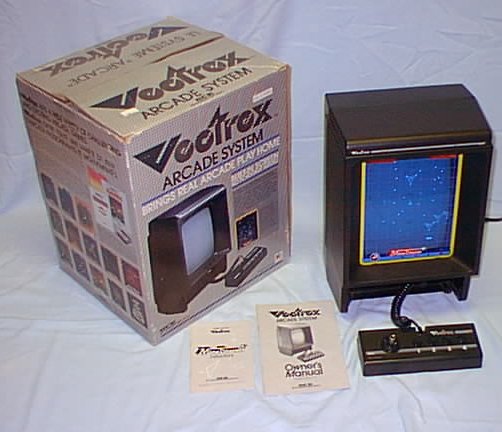A Historical Look at Video Games


The Ancestry of the Arcade
The Birth of the Video Game
On the Go and in the Home
Early Arcade Classics
Competition on the Home Front
Video Games: A Cultural Movement
The Downward Spiral

ColecoVision with four games

ColecoVision Roller Controller

Vectrex system
The video game industry peaked in 1982, marked by annual sales that reached three billion dollars. Disney amazed movie-goers with Tron, a film that took you inside an arcade game with the help of computer generated graphics and animation. The popularity of this film illustrated how video games had become a major part of our culture. A stand-up game based on the movie was released by Bally/Midway at the same time that Williams released Joust, the first two-player cooperative play game.
A flood of new home video game systems hit the market in 1982. Already a successful developer of software for the 2600 and Intellivision, Coleco released their own video game system, ColecoVision. It boasted ten times the screen RAM of the Intellivision, manipulating up to 48 objects on screen simultaneously, and could play games as big as 32K ROM. ColecoVision captured a big percentage of the market largely because Coleco offer a peripheral called the Conversion Module that adapted units to play all Atari VCS compatible software. Packaged with a home version of Nintendo's Donkey Kong, ColecoVision was enhanced by a steady stream of successful software titles and intriguing controllers like the Roller Controller, the Super Action Joystick and the Driving Module.
While Coleco was capturing the hearts and dollars of gamers everywhere, Atari was gearing up for a Christmas release of their 'Super game' unit, the 5200 Advanced Video Entertainment System. The 5200 was superior to the 2600 in the areas of graphics and speed due to a 6502 processor, the same size type found in the 8-bit Nintendo system. It contained 16k of computer memory and a digital component to reproduce speech. The downfall of the 5200 was that it had nothing particularly innovative about it. It played all the 2600 games with better graphics, but the game play improvement wasn't enough to sway many 2600 owners. The same titles were being released for both systems, as well as the ColecoVision and Intellivision, so few gamers were influenced by game libraries. In addition, the original 5200 controller lacked durability and suffered from the same slow response as Intellivision's. Its release sparked the industry's first big market share battle between Atari and Coleco.
Atari and Coleco weren't the only companies vying for the consumers. Mattel was hard at on the new and improved Intellivision II and the Aquarius Computer. Sears had their Super Telegames System, compatible with 2600 and Intellivision games, and Magnavox had released the Odyssey2. GCE, the company behind the Game Time and Arcade Time watches, introduced the Vectrex game system. This stand-alone unit was composed of a black and white vector monitor, similar to those found in arcade games, and a system base not unlike the early 1990's Macintosh. Its vector monitor allowed the tranlation of arcade smashes such as Asteroids, Battle Zone, Star Castle and Tempest into the home. Astrovision's Astro Professional Arcade system made its second appearance on the market, this time under the name Astrocade. It was originally introduced by Bally in 1976 as a 4K color computer with two built-in games; Gunfight and Checkmate. Initially, it confused consumers by functioning both as a game system and a computer, and was eventually forced off the market by the lower-priced Atari system. The Astrocade fared better in its second release, but it was the calm before the storm.